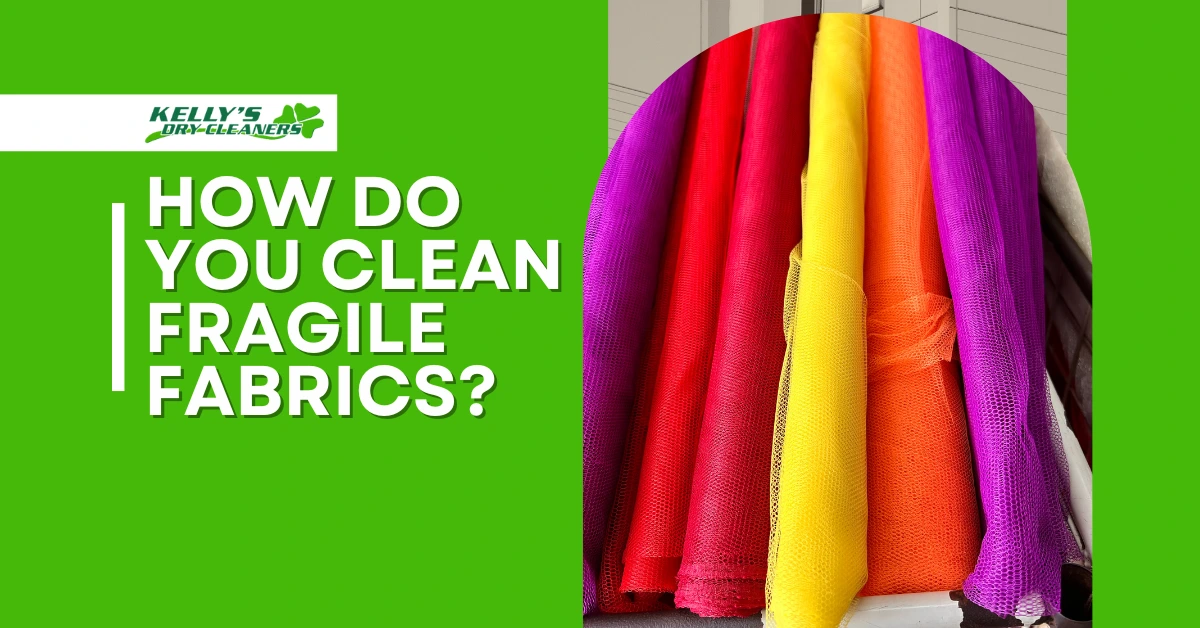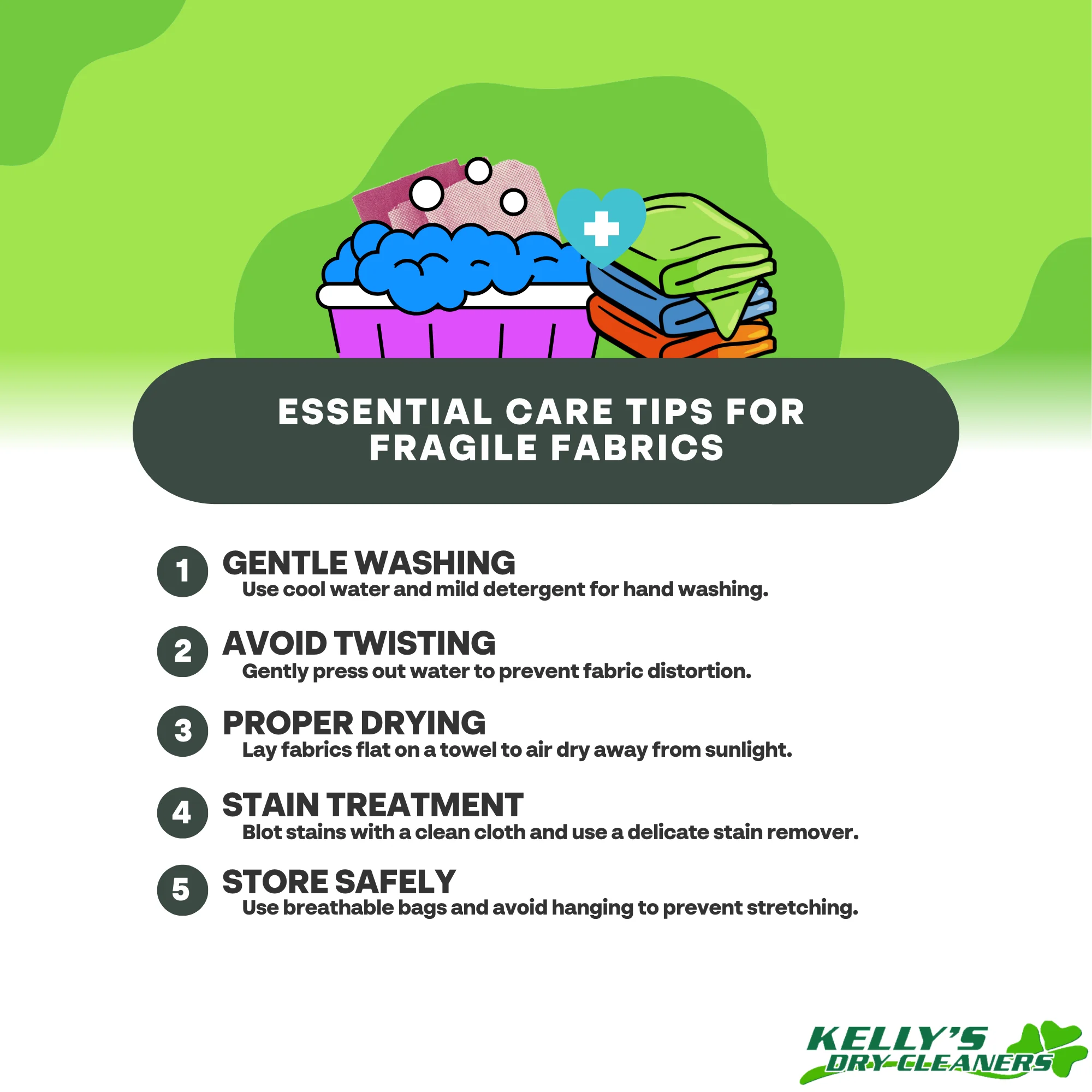To clean fragile fabrics like silk or lace, always hand wash whenever possible. Start by filling a clean basin with cool water and adding a mild detergent designed for delicate items. Soak the fabric for about 5-10 minutes, gently agitating the water to help lift dirt. Avoid wringing or twisting to prevent damage. Rinse under cool running water until the soap is fully removed. For stains, act quickly by blotting with a clean cloth and using a delicate stain remover. Finally, lay the item flat on a towel to dry naturally. There’s much more to explore about caring for these fabrics effectively.
Key Takeaways
- Hand-wash fragile fabrics in cool water with a mild detergent to prevent damage.
- Soak the item for 5-10 minutes, gently agitating the water without wringing.
- Rinse thoroughly under cool running water to remove all soap residue.
- Air dry delicate items flat on a towel, away from direct sunlight.
- Store cleaned fabrics in breathable garment bags to protect from dust and damage.
How to Hand-Wash Delicate Clothing
To hand-wash delicate clothing effectively, start by gathering all necessary supplies: a clean basin, mild detergent specifically designed for fragile fabrics, and cool water.
Avoid using harsh detergents, as they can damage the fibers.
Fill the basin with cool water and add a small amount of the mild detergent, mixing gently to create a soapy solution.
Submerge the delicate item and let it soak for about five to ten minutes. This allows the detergent to penetrate the fabric and helps in cleaning delicate fabrics without harsh scrubbing.
After soaking, gently agitate the water with your hands, but avoid wringing or twisting the clothing, as this can distort its shape.
Rinse the item under cool running water until all soap is removed.
Once rinsed, lay the delicate clothing flat on a clean, dry towel and roll it up to absorb excess water.
Finally, reshape the garment and air dry it away from direct sunlight or heat sources.
Following these steps guarantees that you handle delicate fabrics with care, preserving their beauty and longevity.
What Is Delicate Clothing?
After learning how to hand-wash delicate clothing, it’s important to understand what qualifies as delicate fabric. Delicate fabrics are materials that require special care due to their fragility and susceptibility to damage. Common examples include silk, lace, chiffon, and certain types of wool.
These fabrics often have a lightweight, sheer, or intricate structure that makes them prone to tearing, fraying, or shrinking if not handled properly.
When you’re dealing with delicate clothing, you should also consider the embellishments. Beads, sequins, and embroidery can easily be damaged during regular washing processes, so extra caution is necessary.
Additionally, delicate fabrics often absorb water differently than sturdier materials, which can lead to color bleeding or distortion if exposed to harsh detergents or aggressive washing techniques.
Recognizing delicate fabrics is vital for maintaining their quality and longevity. Always check care labels for specific washing instructions, and remember that when in doubt, hand-washing is typically the safest method.
Treat your delicate clothing with care, and you’ll guarantee that these beautiful pieces last for many seasons to come.
How Often to Wash Delicate Clothing
Washing delicate clothing requires a thoughtful approach, as over-cleaning can lead to unnecessary wear and tear. You should aim to wash your delicate items only when necessary. A good rule of thumb is to wash after three to five wears, depending on how soiled they become.
Fabrics like silk, lace, and chiffon can often retain odors and moisture, so be attentive to any signs of dirt or perspiration.
For items that are particularly fragile or have intricate details, consider dry cleaning them instead of regular washing. Dry cleaning fabrics helps preserve their quality, as harsh detergents and aggressive washing methods can degrade their fibers.
When you do wash at home, always use cold water and a gentle detergent designed for delicate textiles. If you can, opt for the delicate cycle on your washing machine, or better yet, hand wash when possible.
Remember, less is more when it comes to washing delicate items. Keeping them clean while minimizing wear will extend their lifespan and maintain their beauty.
Regularly inspect your delicate clothing for any signs of damage, as this can help you determine when it’s time for professional care.
Treating Stains on Delicate Clothing
When faced with a stain on delicate clothing, it’s crucial to act quickly to prevent permanent damage. First, gently blot the stain with a clean, white cloth to absorb any excess liquid. Avoid rubbing, as this can spread the stain and damage the fabric.
Next, choose a stain remover for delicate fabrics, specifically formulated to treat sensitive materials without causing harm. Before applying the stain remover, test it on a hidden area of the garment to verify it won’t cause discoloration or damage.
If the test goes well, follow the product instructions carefully. Typically, you’ll apply a small amount directly onto the stain, allowing it to sit for a few minutes. This process helps to lift the stain without compromising the fabric’s integrity.
After letting the stain remover work, gently blot again with a clean cloth. Rinse the area with cold water to remove any remaining product.
Care and Repairs
Once you’ve successfully treated any stains on your delicate fabrics, it’s important to focus on their ongoing care and repairs to maintain their beauty and longevity.
First, always store fragile fabrics properly. Use breathable garment bags and avoid plastic, which can trap moisture. If you notice small tears or fraying, repair them promptly. Use a needle and thread that matches the fabric, and make tiny, discreet stitches to prevent further damage.
For cleaning, consider using dry cleaning fluid for fine fabrics. Test it on a hidden area first to verify it won’t cause discoloration. Apply the fluid gently with a clean cloth, using a dabbing motion to lift dirt without damaging the fibers.
Be cautious with washing machines; if you must machine wash, use a delicate cycle and a mesh bag to protect your garments.
Regularly inspect your fabrics for signs of wear or fading. If you see any issues, address them immediately to prevent escalation.
Ironing
How can you effectively iron fragile fabrics without risking damage? Start by checking the care label, as it often provides specific instructions for cleaning delicate fabrics.
Set your iron to the lowest heat setting, typically labeled as “silk” or “delicate.” It’s essential to let the iron warm up gradually to avoid overheating.
Next, place a thin cotton cloth or a pressing cloth over the fabric. This layer acts as a barrier, protecting your delicate item from direct heat and potential scorch marks.
Always keep the iron moving in short, gentle strokes. Avoid leaving it in one spot for too long, as this can create shiny patches or burn the fabric.
If your delicate fabric is heavily wrinkled, consider using steam instead of direct heat. Hold the iron a few inches away from the fabric and let the steam do the work. This method is gentler and reduces the risk of damage.
After ironing, let your fabric cool flat on a clean surface to maintain its shape. By following these tips, you can guarantee your fragile fabrics stay pristine while you tackle the task of ironing.
Storing Delicate Clothing
Properly storing delicate clothing is essential for maintaining its quality and extending its lifespan. When you store these items correctly, you minimize the risk of damage, such as tearing or fading, which can occur if they’re mishandled.
To guarantee your delicate fabrics stay in top condition, consider the following tips:
- Use breathable garment bags: Opt for cotton or muslin bags to protect against dust while allowing air circulation.
- Avoid hangers: Instead of hanging delicate fabrics, which can lead to stretching, fold them gently and place them in a drawer or on a shelf.
- Keep away from direct sunlight: Store your items in a dark, cool place to prevent fading and deterioration caused by UV rays.
- Separate by fabric type: Group similar fabrics together to avoid potential damage from friction or snagging during storage.
Additionally, guarantee your delicate clothing is clean before storing it.
Cleaning delicate fabrics effectively helps to prevent stains from setting, which could become permanent if left unattended.
Tips for Washing Delicate Clothing
Washing delicate clothing requires care and attention to detail to preserve its beauty and integrity. Start by checking the care label for specific instructions. Always choose a gentle detergent designed for cleaning delicate fabrics; harsh chemicals can damage fibers.
Before washing, turn garments inside out to minimize friction and protect embellishments. Use a mesh laundry bag to separate delicate items from heavier fabrics, reducing the risk of snagging. If you’re using a washing machine, opt for the delicate cycle with cold water.
Hand washing is often the safest method; simply fill a basin with cool water and add the detergent, then gently agitate the water before submerging the fabric. Avoid wringing out delicate clothing, as this can stretch or tear the fibers.
Instead, press the water out by laying the garment flat on a clean, dry towel and rolling it up. Finally, air dry your delicate items away from direct sunlight to prevent fading. By following these tips for washing delicate clothing, you’ll guarantee your favorite pieces remain beautiful and last for many seasons to come.
Frequently Asked Questions
Can I Machine Wash Fragile Fabrics on a Gentle Cycle?
You might think machine washing fragile fabrics on a gentle cycle is safe, but beware! Always check care labels first. If allowed, use a mesh bag and mild detergent to protect your delicate items effectively.
What Temperature Is Safe for Washing Delicate Materials?
When washing delicate materials, stick to cold or lukewarm water, ideally under 30°C (86°F). This minimizes the risk of damage, ensuring your fabrics stay vibrant and intact for longer. Always prioritize gentle handling.
Are There Specific Detergents for Fragile Fabrics?
Think of delicate fabrics as precious flowers; they need gentle care. When washing, use detergents specifically designed for fragile materials. These products protect fibers, maintain colors, and guarantee your fabrics stay vibrant and intact longer.
How Do I Dry Delicate Clothing Without Damaging It?
To dry delicate clothing, lay it flat on a clean, dry towel, reshaping it gently. Avoid wringing or hanging, which can distort shapes. If using a dryer, select a low heat setting with a mesh bag.
Can I Use Bleach on Fragile Fabrics?
You shouldn’t use bleach on fragile fabrics. It can weaken fibers and cause discoloration. Instead, opt for gentler alternatives like mild detergents or spot-cleaning techniques to maintain your delicate garments’ integrity and appearance.
Conclusion
In conclusion, cleaning fragile fabrics requires a gentle touch and careful attention. For instance, if you have a beloved silk blouse with a small stain, hand-washing it with a mild detergent can preserve its beauty. Always test any cleaning method on a hidden area first to avoid damage. By following these guidelines, you can guarantee your delicate garments remain in pristine condition for years to come, allowing you to cherish them even more.




